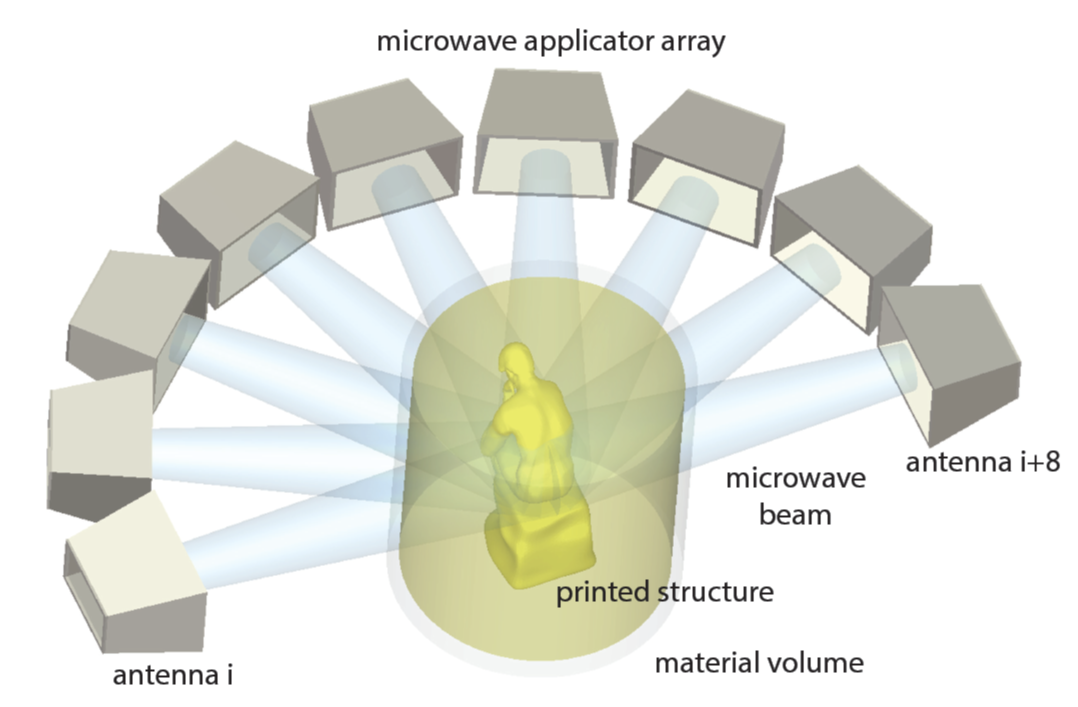Researchers at LLNL have developed Computed Axial Lithography (CAL) that unlike most additive manufacturing (AM) methods, printed parts could be fabricated in a single step. The advantage of this Volumetric Additive Manufacturing (VAM) approach is the capability to print arbitrarily defined 3D geometries at high speed and without stair-step artifacts from layering. However, like other light-based AM methods, CAL is limited to transparent photosensitive liquid resin feedstock materials due to the high attenuation of light waves within optically opaque materials.
Through numerical simulation studies on shaping microwave beams, LLNL researchers have been able to demonstrate microwave energy localization as well as the ability to focus the microwaves to a desired shape. The simulations were supported with experimental results on feedstock epoxy resins loaded with a wide range of opaque additives; regions in the feedstock with high localized fields were the areas that had localized thermal curing of the resin.
With Microwave Volumetric Additive Manufacturing (MVAM), the design space of VAM could broaden beyond the limited optically transparent 3D printing feedstocks and chemistries required by light-based VAM such as CAL.
LLNL’s MVAM method comprises of a microwave applicator array coupled to a time-reversal beam steering algorithm to focus and deposit microwave energy in the feedstock material. The selective focusing of high-power microwave fields results in delivery of localized energy to arbitrary regions in a 3D volume. The localized area in the 3D volume heats up, allowing for the curing, sintering or binding of feedstock material in that location.
MVAM enables selective thermal-mediated chemistries and processes during the fabrication of the 3D printed part, which could take place in various ways:
- Single Applicator MVAM – 3D generation of full objects completed in a single step. Instead of using multiple waveguide applicators to control the energy field, a single applicator could be used with complex adaptable lens.
- Microwave Direct Ink Write (MIW) – a pseudo 1D localization of a microwave-induced thermal hotspot which can be moved on X-Y gantry; objects in this case are built layer-by-layer through the writing with the hotspot.
- Microwave Stereolithography (M-SLA) – 2D masking of microwaves to create slices of printed material, similar to photomasking methods of SLA; objects can be built up slice by slice
Publications:
S. Mukherjee, J. Schwartz, T. Chang, E. Baluyot, J. Tringe and M. Shusteff, "Focused microwave radiation for the localized curing of polymer resins," 2022 IEEE International Symposium on Antennas and Propagation and USNC-URSI Radio Science Meeting (AP-S/URSI), Denver, CO, USA, 2022, pp. 159-160 (https://doi.org/10.1109/AP-S/USNC-URSI47032.2022.9886029)
S. Mukherjee, R. O. Mays and J. W. Tringe, "A Microwave Time Reversal Algorithm for Imaging Extended Defects in Dielectric Composites," in IEEE Transactions on Computational Imaging, vol. 7, pp. 1215-1227, 2021 (https://doi.org/10.1109/TCI.2021.3125925)
- Unlike light-based AM methods, microwaves can induce the thermal curing, sintering and binding of non-transparent or non-photosensitive feedstock materials that could be in the form of a liquid, gel, paste, solid or composite, thus expanding the VAM paradigm to a wider range of materials.
- Feedstock could also include particle additives such as piezoresistive and conductive carbon black, ceramic particulates or chemically active inorganic catalysts.
- Since microwaves can penetrate farther than light, large area printing with a broad range of materials is enabled with MVAM.
- Additionally, the technology can enable volumetric processing of opaque particulate samples by microwave sintering under pressure.
- 3D printing of opaque (non-transparent) materials, including glass, ceramic and other composites.
- The high sensitivity of microwaves towards certain particles mixed in the feedstock opens up applications towards developing novel functional electronic devices, such as energy storage, metamaterials, and piezo-sensitive sensors.
Current stage of technology development: TRL 2
U.S. Patent Application No. 2023/0135458 System and Method for Microwave Volumetric Additive Manufacturing published 05/04/2023
U.S. Patent Application No. 2024/0181699 SYSTEMS AND METHODS FOR MICROWAVE ADDITIVE MANUFACTURING published 06/06/2024


